UV-Visible/NIR Spectrophotometer UH5700
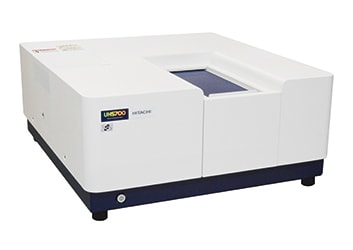
Opening the way to the future, the UH5700, the spectroscopy specialist, handles the ultraviolet, visible, and near-infrared regions and strongly supports you.
Features
Handling the ultraviolet, visible, and near-infraredregions (190 to 3,300 nm), the UH5700 achieves both high measurement precision and high throughput
Use of a continuously variable slit
The UH5700 employs a continuously variable slit in the near-infrared region, in which the slit automatically widens when measuring low quantities of light and narrows when measuring large quantities of light, and thereby achieves low-noise measurements across a broad range of measurement wavelengths from 190 to 3,300 nm.
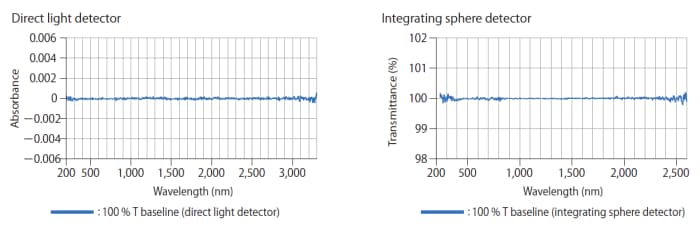
Low stray light
The UH5700 achieves best-in-class levels of low stray light and high photometric range through use of a Czerny-Turner mounted single-monochromator bright spectrometer and a newly developed grating using photolithography technology. *1
*1 Hitachi High-Tech Science survey of models marketed within Japan (single monochromator instruments supporting near-infrared wavelength range) as of April 2019
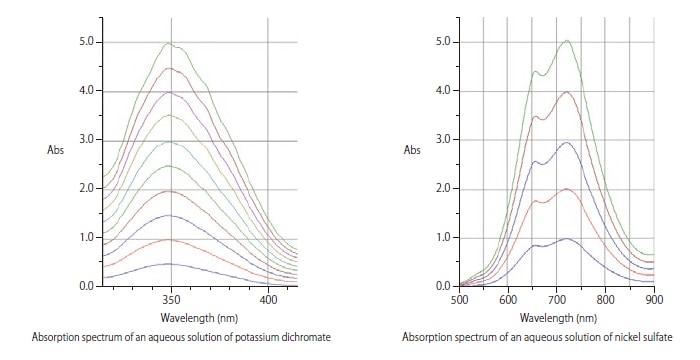
Measurement throughput improvements
By employing a gear-drive system for the wavelength drive, high scanning speeds compared to conventional instruments are achieved of approximately 0.3 to 5,000 nm/min in the ultraviolet-visible region. *2 When measuring at a 1 nm interval, a measurement made at 1,000 nm/min in the 190 to 3,300 range can be completed in approximately 4 minutes.
*2 U-3900 : 1.5 to 2,400 nm/min, U-2900 : 10 to 3,600 nm/min.

Control of detector switching level difference
Generally, UV-visible/near-infrared spectrophotometers use different detectors in the UV-visible region and the near-infrared region. Because different detectors are used, a difference in photometric values may arise in switching between detectors. Through know-how developed from the fundamentals, signal processing technology, and other techniques, the UH5700 holds the level difference when switching detectors to a minimum.
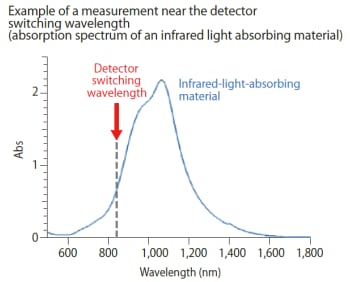
Common utilization of accessories
The sample compartment shares a common design with the U-2900/U-3900 spectrophotometers, so you can use the accessories you already have.*3 We offer an extensive line-up of accessory types tailored to measurement objectives.
*3 Except for certain accessories (please check with your sales representative for details)
Options
Accessory line up to support a broad range of measurements
The sample compartment shares a common design with the U-2900/U-3900, so existing accessories can be used. *
* Except for certain accessories (please check with your sales representative for details)
For measurement of liquids
Micro cell option
Micro cells are used in combination with a mask (200- 1537). A micro cell is suitable for small samples with volumes of 340 to 600 µL.
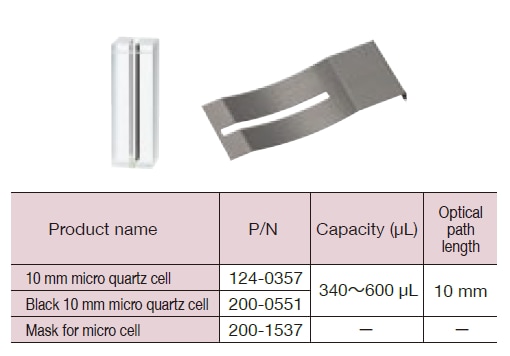
Ultra-micro volume sample measurement option
Trace sample cells are used in combination with a mask (3J1-0116) (2 included). These are suitable for ultra-micro volume with volumes of 1.5 to 90 µL.
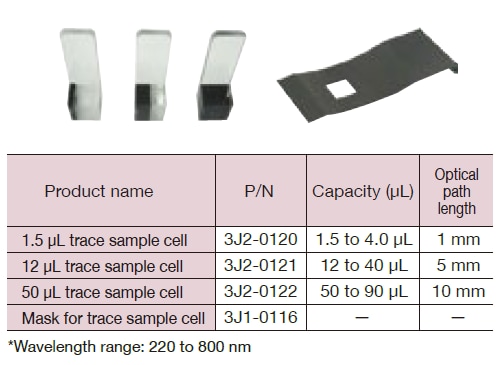
Rectangular long-path cell holder (P/N 210-2107)
This holder is used when using rectangular long-path cells. Low-concentration samples can be measured with a high degree of sensitivity.
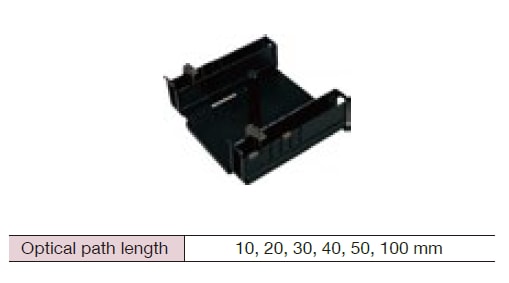
Reference-side attenuation filter holder (P/N 2J3-0120)
This is used when you wish to expand the photometric range of the near-infrared region. To perform a measurement where you want to expand the photometric range in the near-infrared region, a NENIR210B near- infrared absorbing ND filter made by Thorlabs, Inc. described in the table below is needed in addition to a reference-side attenuation filter holder (2J3-0120).
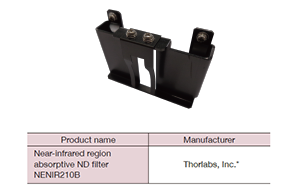
Water-circulating cell holder (P/N 210-2111)
Water from a thermostatic circulating water bath is circulated in the cell holder, and the cell section is kept at a constant temperature. (Temperature control: both R and S)
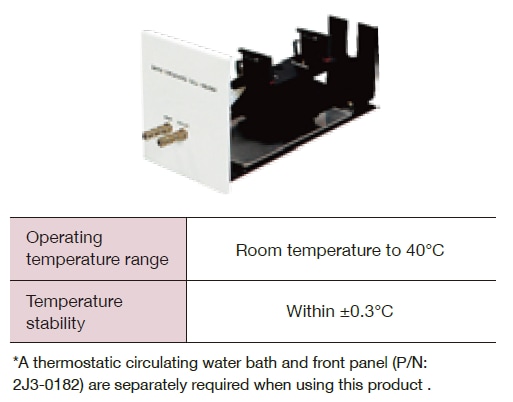
Thermostatic cell holder with stirrer (P/N 2J3-0161)
A magnetic stirrer agitates the sample solution to limit the effect of temperature variation.
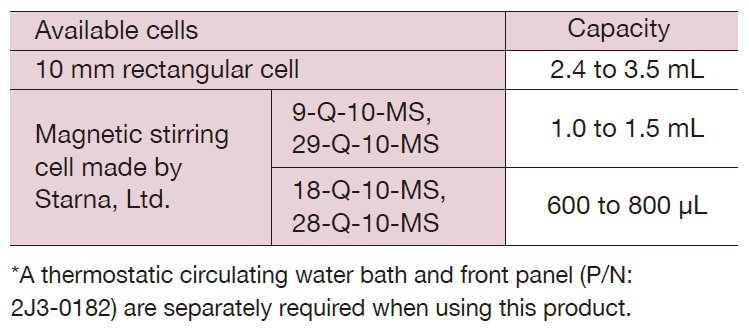
Programmable thermostatic cell holder (P/N 131-0301, 131-0302)
In protein and nucleic acid melting measurements, the sample temperature can be changed continuously to determine the variation in absorbance. Because it is heated and cooled electronically, this cell holder is capable of rapid heating and cooling. The sample temperature can be increased and decreased isothermally, and because this holder is equipped with a stirrer, there is no temperature variation within the cell. (temperature control: both R and S)
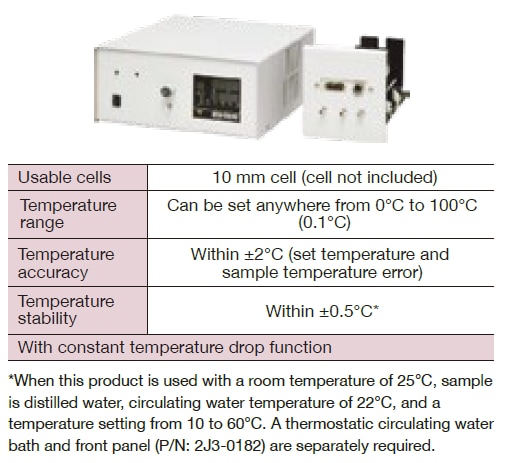
Auto sipper (P/N 2J3-0131)
By pressing the front sipping lever, a sample can be drawn in from the suction nozzle and tested. The auto sipper is suitable for multiple sample measurements. By connecting it to an autosampler, analyses can be performed automatically, achieving labor savings.
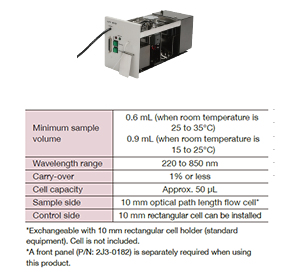
Electronic thermostatted auto sipper (P/N 2J3-0141)
This auto sipper can maintain the flow cell at a constant temperature.
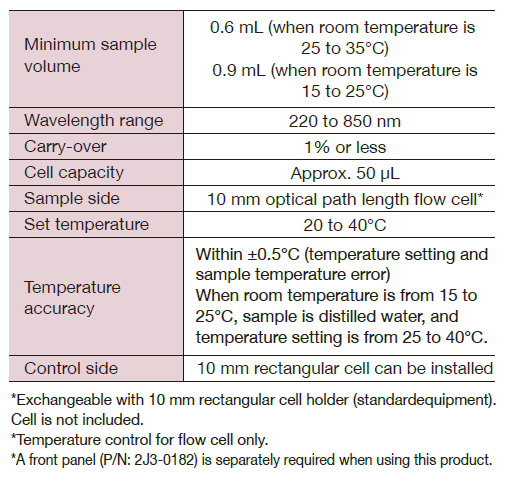
AS-1010 Auto Sampler (P/N 2J1-0121, 2J1-0122)
In combination with an auto sipper, this unit can make multiple automatic measurements of solution samples. A suction needle can be moved in three (XYZ) directions.
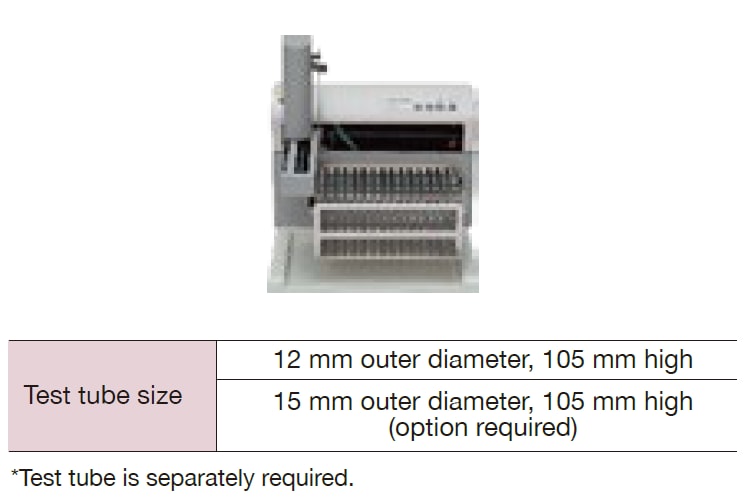
For measurement of solids
Φ60 Integrating Sphere (P/N 2J3-0176)
This is used for absorbance measurements of turbid samples and reflectance measurements of solid sample surfaces.
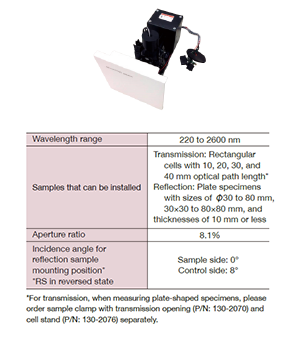
5° Specular Reflectance Accessory (relative)(P/N 2J3-0151)
This accessory uses the mirror reflection of a sample to measure relative reflectance with respect to a standard reflection plate (aluminum-evaporated plane mirror). This is used for film thickness measurement, spectral reflectance measurement, and other such applications.
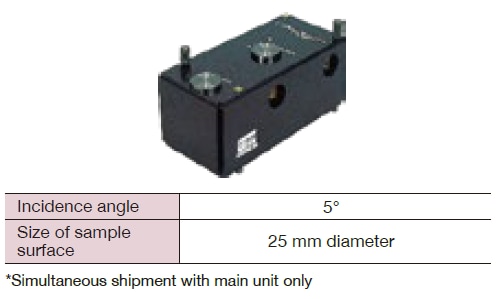
Glass filter holder (P/N 210-2109)
This holder is used for measuring the transmittance and absorbance of solid plate samples such as glass filters.
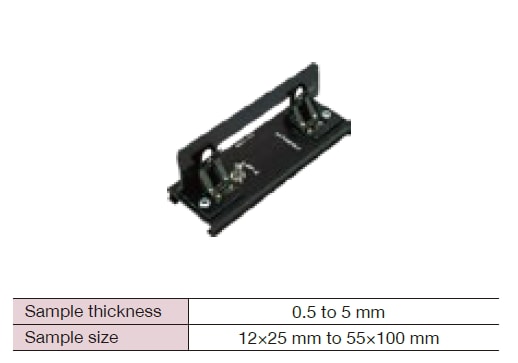
Film holder (P/N 210-2112)
This holder is used for measuring the transmittance and absorbance of film-like samples.
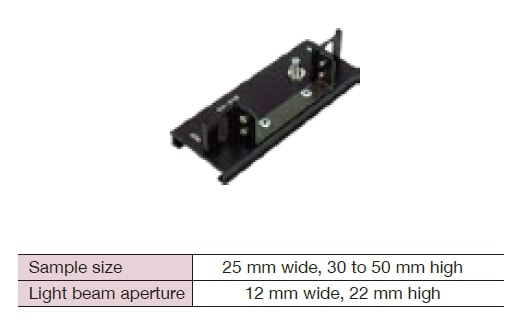
Polarizer holder (P/N 210-2130)
The sample beam is linearly polarized, and the polarization properties are measured. This can be used in combination with an analyzer.
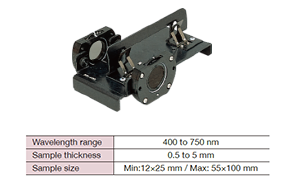
Φ60 Integrating Sphere (P/N 2J3-0176)
This holder set is used when carrying out wavelength calibration or verification of wavelength accuracy using a mercury lamp. The set includes a holder to install the mercury lamp in the device and a purpose-built light source chamber cover. In addition to this product, to carry out measurements using the mercury lamp, a pen-type low-pressure mercury lamp 81-1057-98 made by BHK, Inc. and a BHK purpose-built power source 90-0005-01 are required.
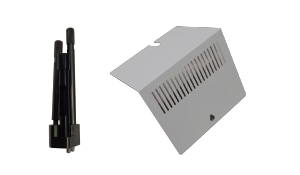
Optional software
Option Package Program (P/N 2J3-0191)
The UV Solutions Plus optional software is for performing calculations based on a wide variety of JIS Standard tests and various optical characteristics.
By installing this program, calculations such as color calculations, direct light/solar calculations (glass), and solar reflectance paint calculations can be performed.

Specifications
| Item | Description |
|---|---|
| Optics | Czerny-Turner monochromator Single monochromator, Double beam |
| Wavelength range | 190~3300 nm |
| New features of standard software |
List display feature for data processing results
Specific wavelength data, area calculation data, half-value width calculation data and other data across multiple samples can be displayed in tabular form. Comparing data between samples can be done easily. |
|
Reporting function
You can freely lay out printable items such as analysis conditions, data processing results, spectra, etc. with the report layout feature, which did not exist in the UV Solutions software in the past. |
|
|
Standard installation of performance confirmation feature
This feature can check for proper function and performance on a daily basis. Performance confirmation feature items: wavelength accuracy, noise level (RMS), baseline flatness, etc. |
Example of application
Measurement of hexavalent chromium (diphenylcarbazide absorptiometry)
We present an example of analysis by diphenylcarbazide absorptiometry of hexavalent chromium, which is subject to regulation by the RoHS directive. Hexavalent chromium was measured using “Reagent Set for Water Analyzer No. 31 Chromium (Hexavalent)” made by Kyoritsu Chemical-Check Lab., Corp. From the absorption spectrum measurement results, the presence of an absorption peak at a wavelength of 540 nm was confirmed. Good linearity was obtained for the calibration curve at the 540 nm absorption peak with R2 = 1.0000.

Measurement of silica (molybdenum yellow absorptiometry)
The measurement for silica by molybdenum yellow absorptiometry is prescribed in JIS K0101 Testing Methods for Industrial Water. Silica was measured using “Reagent Set for Water Analyzer Silica” manufactured by Kyoritsu Chemical-Check Lab., Corp. From the absorption spectrum measurement results, the presence of an absorption peak at a wavelength of 815 nm was confirmed. Good linearity was obtained for the calibration curve at the 815 nm absorption peak with R2 = 0.9999.

Measurement of absorption spectrum of near-infrared light absorbing dyes
Near-infrared light absorbing dye powders were dissolved in toluene to produce samples for measurement. Spectra were obtained with maximum absorption peaks around wavelengths of 800 to 1000 nm. Spectra were obtained with a low step size at the detector switchover wavelength of 850 nm. The wavelength range and detection method used can be set in the UV Solutions Plus specialized software, and multiple peaks can be simultaneously detected. In addition, peak detection results can be displayed in tabular form.
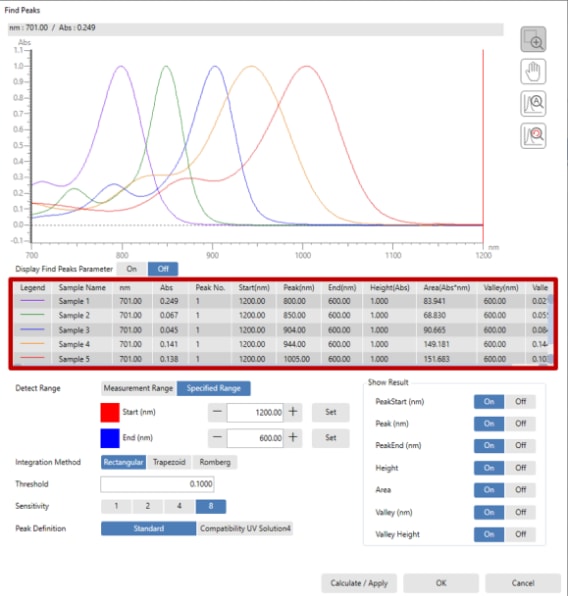
Measurement of filters
Filters allow light at specific wavelengths to pass through. Filters A, B, and C passed light in the blue, green, and red regions, respectively, and filter D passed light in the entire visible region.

Color measurement (optional package)
The light source, field of view, and other such parameters were set using spectra from the standard method (wavelength range 360 to 830 nm, 1 nm interval) and the practical method (wavelength range 380 to 780 nm, 5 nm interval), and color calculations were carried out. Color calculation results can be plotted onto chromaticity coordinates.
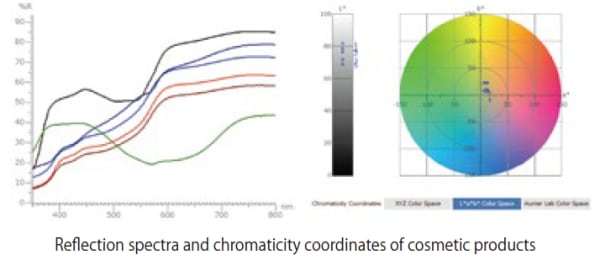
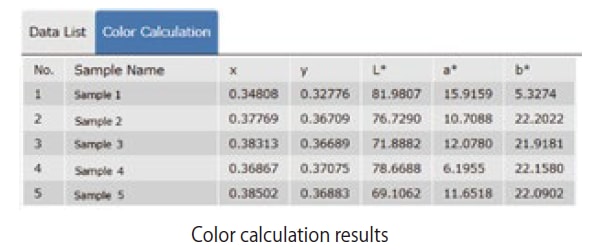
Measurement of window glass and coatings
Near-infrared light from the sun is a source of heat that can pass through glass windows and cause the temperature of a room to rise. Because of this, functional glass has been employed in recent years that cuts near-infrared light. In addition, functional coatings have been used on the outer walls of buildings to reflect near-infrared light. The optical characteristics of functional glass and functional coatings were measured.
- Light/solar direct (glass) calculation results
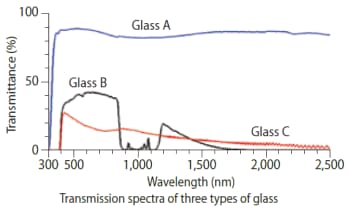
- Calculations using optional package
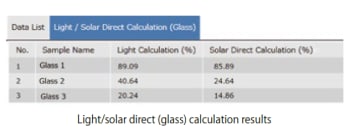
Calculations can be performed that conform to the test methods pertaining to the transmittance (reflectance) of plate glass (visible light transmittance, solar transmittance, solar reflectance) as specified in Japanese Industrial Standards JIS R3106-2019.
- Solar reflectance (paint) calculation results
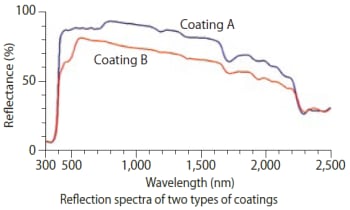
- Calculations using optional package
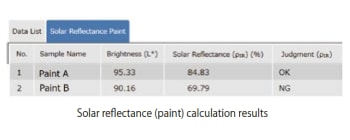
Calculations can be performed that conform to the method for obtaining the solar reflectance of paint specified in Japanese Industrial Standard JIS K5602-2008, and to the test method pertaining to high solar reflectance paint for roof use (solar reflectance) specified in Japanese Industrial Standard JIS K5675-2011.
